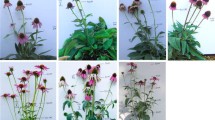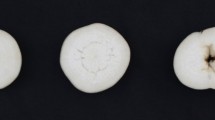Abstract
Studies on induction, isolation and stabilization of tetraploids in Lolium perenne L. (2n=14) are reported. These investigations revealed that:
-
1.
The different varieties of ryegrass responded differentially to colchicine treatment.
-
2.
Colchicine was mutagenic in addition to doubling chromosome number in ryegrass.
-
3.
A high incidence of mixoploidy was obtained following colchicine treatment, which interfered with the fertility of the C0 tetraploids. The tillers, selected cytologically for tetraploid purity, had a higher seed set and 100-grain weight than either the mother plant or the diploid variety.
-
4.
In the C1 generation, obtained from the interpollination of pure tetraploid tillers, about 92 per cent plants were tetraploid (2n=28), 7 per cent aneuploid (2n=25, 26,27) and less than one per cent diploid.
-
5.
There was no significant difference in the percentage recovery of the tetraploids from small and large seeds in the C1 generation.
Similar content being viewed by others
References
Ahloowalia, B. S., 1965. A root tip squash technique for screening chromosome number in Lolium. Euphytica 14: 170–172.
Ahloowalia, B. S., 1965. Cytogenetic studies on natural hybrids between ryegrass and meadow fescue. Z. VererbLehre 97: 226–242.
Carnahan, H. L. and Hill, Helen, D., 1955. Lolium perenne L. × tetraploid Festuca elatior L. triploid hybrids and colchicine treatments for inducing autoallohexaploids. Agron. J. 47: 258–262.
Cooper, J. P., 1963. Germination responses. Rep. Welsh Pl. Breed. Stn. 1962. 14–15.
Cooper, J. P. and Rhodes, I., 1964. DNA replication in climatic races. Rep. Welsh Pl. Breed. Stn. 1963. 18–19.
Dyck, P. L. and Rajhathy, T., 1965. A desynaptic mutant in Avena strigosa. Can. J. Genet. Cytol. 7: 418–421.
Franzke, C. J. and Ross, J. G., 1952. Colchicine-induced variants in Sorghum. J. Hered. 43: 107–115.
Franzke, C. J. and Sanders, Mary E., 1964. Classes of true-breeding diploid mutants obtained after colchicine treatment of Sorghum line Experimental 3. Bot. Gaz. 125: 170–178.
Fürste, K., 1962. Welsches Weidelgras (Lolium multiflorum) Tetraploid. Z. PflZücht. 47: 369–387.
Griffiths, D. J. and Pegler, R. A. D., 1964. Natural crossing between diploid and tetraploid ryegrass varieties. Rep. Welsh Pl. Breed. Stn. 1963. 79–80.
Hertzsch, W., 1959. Beobachtungen an künstlich hergestellten polyploiden Futterflanzen. 3. Welsches Weidelgras (Lolium multiflorum). Z. PflZücht. 41: 271–293.
Hill, Helen, D. and Myers, W. M., 1944. Isolation of diploid and tetraploid clones from mixoploid plants of ryegrass (Lolium perenne L.), produced by treatment of germinating seeds with colchicine. J. Hered. 35: 359–361.
Hutton, E. M., 1957. Some effects of induced autopolyploidy in white clover, barrel medic and Wimmera ryegrass. J. Aust. Inst. Agric. Sci. 23: 227–231.
Myers, W. M., 1939. Colchicine induced tetraploidy in perennial ryegrass. J. Hered. 30: 499–504.
Myers, W. M., 1944. Cytological studies of a triploid perennial ryegrass and its progeny. J. Hered. 35: 17–23.
Roo, R.de, 1952. Het verwekken van tetraploïdie in enkele voedergewassen door middel van colchicine. Meded. LandbHoogesch. OpzoekStns. Gent. 17 (2): 281–292.
Roo, R.de, 1952. Een dubbel steriele variant in tetraploid materiaal van Lolium perenne. Meded. LandbHoogesch. OpzoekStns. Gent. 17 (3): 554–563.
Schumann, G., 1960. Eine neue Methode zur Colchicinierung von Gramineen und grosskörnigen Leguminosen. Züchter 30: 118–120.
Shalygin, I. N., 1941. Production of tetraploids in Lolium by treating germinating seeds with colchicine. Comptes Rendus (Doklady) de l'Académie des Sciences de l'U.R.S.S. 30: 527–529.
Stuczynski, E., Kaminska, J. and Naleczynska, A., 1963. Tetraploid Westerwold ryegrass (Lolium multiflorum var. westerwoldichum). Genet. polon. 4: 303–308.
Sullivan, J. T., 1944. Further comparisons of plants with different chromosome numbers in respect to chemical composition. J. Amer. Soc. Agron. 36: 537–543.
Sullivan, J. T. and Myers, W. M., 1939. Chemical composition of diploid and tetraploid Lolium perenne L. J. Amer. Soc. Agron. 31: 869–871.
Tiemann, H., 1960. Die Erzeugung und Erkennung von Tetraploiden bei Gramineen. Züchter 30: 202–205.
Wit, F., 1958. Tetraploid Italian ryegrass (Lolium multiflorum Lam.). Euphytica 7: 47–58.
Wit, F., 1959. Chromosome doubling and the improvement of grasses. Genet. Agraria 11: 97–115.
Wit, F. and Speckmann, G. J., 1955. Tetraploid Westerwolths ryegrass. Euphytica 4: 245–253.
Author information
Authors and Affiliations
Rights and permissions
About this article
Cite this article
Ahloowalia, B.S. Colchicine induced polyploids in ryegrass. Euphytica 16, 49–60 (1967). https://doi.org/10.1007/BF00034098
Received:
Issue Date:
DOI: https://doi.org/10.1007/BF00034098




